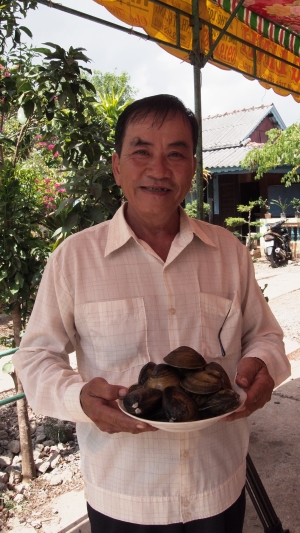A model shrimp farm in the Mekong Delta
Get to know Mr Bui Thanh Cong, shrimp farmer and MFF project beneficiary
Location: Tra Vinh, Viet Nam. 12th Jun 2015
Cong owns around nine hectares of land. Like his neighbours, Cong's production is mostly reliant on intensive farming which is extremely unsustainable because it clears away mangroves and is heavily dependent on chemical inputs. Cong’s production took a turn, however, when he agreed to be part of a pilot project to explore alternative technologies for environmentally friendly shrimp farming.
Cong is a beneficiary of a small grant from Mangroves for the Future (MFF) which is working through the Research Institution for Aquaculture 2 (RIA2) in Tra Vinh to get farmers to shift away from intensive shrimp farming and to maintain or expand mangrove cover in their shrimp farms.
What MFF and RIA2 are promoting is extensive shrimp farming using mangrove-based polyculture with shrimp, crabs and mud clams. Polyculture is an agriculture technique where different crops occupy the same plot, imitating nature’s diverse ecosystems. In aquaculture, it is farming different species (in this case, shrimp, crabs and clams, together with mangroves) in a single pond or a network of ponds. The model is different from intensive shrimp farming, where ponds are cleared of everything—including mangroves—to plant just a single species of shrimp.
It wasn’t hard to convince Cong. Intensive shrimp farming, which can bring big gains, also carries significant risks. Cong was aware of this—the onset of disease in just one shrimp in an intensive shrimp farm can wipe out the entire harvest in one to two days. He decided to give sustainable shrimp farming a try, initially as a buffer to ensure that when disease strikes his intensive farms, he would still have his extensive farms to rely on.
Working with RIA2, he converted 3.5 ha of his farm into a mangrove-based polyculture farm, planting mangroves in a 1.5 ha area while using the remaining two hectares for aquaculture.
Mangrove-based polyculture is an environmentally friendly aquaculture model. Intensive shrimp farms have cleared out the Mekong Delta’s mangroves, leaving little protection for the communities living near the coasts. With shrimp-mangrove polyculture, mangroves are being planted back. Mangroves are the natural habitat of shrimp. These are their feeding and breeding grounds, providing food, shade and shelter. Shrimps in their natural habitat (as opposed to intensive aquaculture farms) are also more resistant to disease.
But Cong went a step further. He dug up a smaller pond, planted mangroves and populated it with mud clams in a bid to pilot a nature-based technology to cleanse water from the river. Mud clams act as natural water filters. His mud clam pond ensured that the water that flowed in and out of his shrimp farm was clean.
Cong’s shrimp ponds also hold a variety of mangroves as well as crabs. Together, the natural environment provides optimal conditions for the shrimp and crabs.
A couple of years into the project, Cong is beaming proudly, happily showing visitors how his extensive shrimp farm works. His profits from the extensive farm are much higher than from his intensive shrimp farm, because he uses almost no inputs. Cong earned around VND 104 million (around USD 4,800) in 2014 from his shrimp-crab-clam polyculture. The amount is three times more than what he earned the previous year. He plans to maintain his extensive shrimp farm, and many of his farmer neighbours visit his farm to learn from his experience.
Converting all his shrimp farms from intensive to extensive aquaculture techniques can be done. However, getting his fellow shrimp farmers to convert will be a process that requires the coordinated efforts, not just of local and national government, but of the private sector as well.
For now, Cong is happy that his farm is being used as a model by the Vietnamese government. The experiences from his demonstration plot have been promoted to other communes in Duyen Hai district through workshops and farmer field schools.
It will take time to convince the majority of the shrimp farms to convert to extensive farming. But the rewards, as farmer Cong can attest, are worth it—both for business, as well as for the environment.

Bui Thanh Cong, shrimp farmer from Tra Vinh, Viet Nam, showi ... , Tra Vinh, Viet Nam © IUCN, 2015